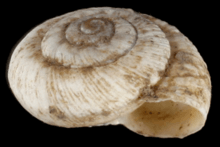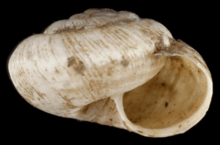Xerocrassa geyeri
| Xerocrassa geyeri Temporal range: early Pleistocene–Recent | |
|---|---|
 | |
| A shell of Xerocrassa geyeri | |
| Scientific classification | |
| Kingdom: | Animalia |
| Phylum: | Mollusca |
| Class: | Gastropoda |
| (unranked): | clade Heterobranchia clade Euthyneura clade Panpulmonata clade Eupulmonata clade Stylommatophora informal group Sigmurethra |
| Superfamily: | Helicoidea |
| Family: | Hygromiidae |
| Subfamily: | Geomitrinae |
| Tribe: | Trochoideini |
| Genus: | Xerocrassa |
| Species: | X. geyeri |
| Binomial name | |
| Xerocrassa geyeri (Soós, 1926)[2] | |
| Synonyms[3][4][5] | |
| |
Xerocrassa geyeri[12][13][14] is a species of air-breathing land snail, a terrestrial pulmonate gastropod mollusk in the family Hygromiidae. It is also often known as Trochoidea geyeri.
Taxonomy
Xerocrassa geyeri was originally described under the name Xerophila geyeri by the Hungarian malacologist Lajos Soós (1879-1972) in 1926.[2] The specific name geyeri is in honor of the German zoologist David Geyer (1855-1932). The type specimens are stored in the Natural History Museum of Geneva.[3]
Shell description
Xerocrassa geyeri is a small land snail. The height of the shell is 3.4-6.0 mm,[3] usually 3.5–5 mm.[11] The width of the shell is 5.1(5.0)[11]-8.0 mm.[3]
The shell is globular in its shape.[3] The shell has 4.5-5 whorls.[3] Sometimes there are radial ribs on the surface of the shell forming its shell sculpture.[3][13] There are usually no periostracal structures,[13] but there can in some cases be hairs[13] and in these cases, after the hairs are gone pits remain on the shel surface especially on the whorl below the apex.[3] The color of the shell is greyish-white[3] sometimes with one or a few brownish spiral bands.[3]
 apical view |
 apertural view. |
 umbilical view |
Anatomy
The reproductive system of Xerocrassa geyeri was described by Gittenberger (1993):[3] there is no appendage in the genital atrium,[3] that is the distinguishing characteristic of the genus Xerocrassa Monterosato, 1892.[3] There are two rudimentary dart-sacs near the mucus glands.[3] The flagellum and the epiphallus have approximately the same length.[3]
Distribution
Xerocrassa geyeri lives in Europe, showing a discontinuous, patchy distribution.[15] Today, the species range is mainly Central Europe: parts of Germany and the south of France.[15] Verified recent localities of Xerocrassa geyeri include:
- Gotland, Sweden[3]
- Belgium[3]
- Germany.[3] It is on the Red List of Germany:[16] critically endangered[12]
- Switzerland:[3] endangered[12]
- France[3]
- Spain[3]
Fossil distribution
Fossil evidence suggests that current populations of Xerocrassa geyeri are relicts of a much more widespread distribution during more favourable climatic periods in the Pleistocene era.[15] Xerocrassa geyeri fossils are relatively abundant[15] and Xerocrassa geyeri was one of main land snails in the western and southern Europe in glacial periods.[17] In loess deposits, the presence of Xerocrassa geyeri shells has been reported since the early Pleistocene.[15] The subfossilised shell deposits in southern England and large parts of France are correlated with the widespread occurrence of rather arid cold steppe vegetation formations.[15] These formations are associated with transitional phases of Pleistocene climate cycles, covering parts of Europe even during maximal glacial expansion thus providing the potential for local refugia.[15] Both Pleistocene interstadial and pleniglacial periods resulted in altitudinal and latitudinal shiftings of these formations, as well as in reductions in their extent.[15]
The fossil record suggests that the population history of Xerocrassa geyeri is linked to palaeoclimate changes.[15] The latitudinal shifts of suitable habitat during Pleistocene across Europe, driven by climate change, were anticipated by Xerocrassa geyeri in the fossil record with remarkably short time lags.[15] In other words, the species can be detected in the fossil record very soon after the onset of a suitable climate phase.[15] Research by Pfenninger et al. (2003)[15] suggested that the origin of the species is in the Provence from where it expanded its range first to Southwest France and subsequently from there to Germany.[15]
Xerocrassa geyeri seems to have survived in local refugia the reduction of the favourable steppe-like habitat due to climatic extremes during the pleniglacial and interstadial periods, as it is the case today. Pfenninger & Bahl (1997)[18] suggested that snail species with restricted dispersal might survive in habitats of a size in the magnitude of few square meters.[15] There is increasing evidence that such small spots with a favourable microclimate existed in the periglacial area of central Europe and were presumed to have provided refuges for comparatively cold resistant snail species.[15] Southern and eastern European refugia were also supplemented by cryptic sanctuaries in northern Europe during the late Pleistocene in shaping present day species composition.[15]
Localities with fossil Xerocrassa geyeri are summarized in Magnin (1989)[19] and they also include:
- United Kingdom:
- southeastern England in interglacial periods: Bramertonian Stage and Cromerian Stage and in Late-Glacial[3]
- Gwithian in Cornwall, south-western England in Late Postglacial in Bronze Age about 3070 ± 103 before present (1993).[3]
- France:
Xerocrassa geyeri can live only in open habitats so it died out in large areas (for example it became extinct in England) when the last glacial period ended and forests started to spread.[3] It had to move to mountains where it survives today.[17]
Ecology
Xerocrassa geyeri is xerophilous species[13] and it is found today in open calcareous or loessic grass and scrublands with a sparse vegetation cover on mountaintops, karstic highland plateaus and disturbed pastures, which are thought to constitute ecological refuges.[15] In southeastern France it inhabits localities from 900 to 1000 m above sea level,[17] but as anomaly it was found also in 370 m above sea level in Mont Vertoux.[17]
Xerocrassa geyeri is hermaphroditic species and fertilisation is obligately outcrossing.[13][15] The main reproduction period is from March to June and from September to October (according table values).[13] It lays usually less than 10 uncalcified egss, but sometimes more (according table values).[13] Juveniles are hatching from eggs in less than two weeks (according table values).[13] They reach sexual maturity in one year[13] and longevity of this species is 1–2 years.[13]
Xerocrassa geyeri feeds on dead plants,[13] but rarely also on living plants, epilithic lichens and on algae.[13] Its active dispersal capacity is about 3 m during its one-year lifetime.[15] Its competitor may be Candidula unifasciata.[17]
See also
Species with similar shell include:
- Helicopsis striata (Müller, 1774)
- Candidula unifasciata (Poiret, 1801)
References
This article incorporates CC-BY-2.0 text from the reference.[15]
- ↑ Falkner, G.; Falkner, M. & von Proschwitz, T. (2013). "Xerocrassa geyeri". IUCN Red List of Threatened Species. Version 2014.2. International Union for Conservation of Nature. Retrieved 27 July 2014.
- 1 2 (in German) Soós L. (1926). "Eine neue Xerophila aus Deutschland, Xer. geyeri, und anatomische Bemerkungen über Xer. barcinonensis (Bgt.)". Archiv für Molluskenkunde 58(2): 96-106.
- 1 2 3 4 5 6 7 8 9 10 11 12 13 14 15 16 17 18 19 20 21 22 23 24 25 26 Gittenberger E. (1993). "On Trochoidea geyeri (Soos, 1926) and some conchologically similar taxa (Mollusca: Gastropoda Pulmonata: Hygromiidae)". Zoologische Mededelingen 67(19): 303-320. Figures 1-29. PDF.
- ↑ "Synonyms of Xerophila geyeri". AnimalBase, accessed 11 April 2010.
- ↑ "Xerocrassa geyeri (Soos, 1926)". Fauna Europaea, accessed 11 April 2010.
- ↑ (in Latin) Mabille J. (1881). "Testarum novarum praesertim europaearum diagnoses". Bulletin de Sciences de la Société Philomatique de Paris (7)5: 122-130.
- ↑ (in French) Locard A. (1882). Prodrome de malacologie Franchise. Catalogue general des mollusques vivants de France. Mollusques terrestres, des eaux douces et des eaux saumatres: i-vi, 1-462. Lyon, Paris.
- ↑ (in French) Berthier H. (1884). "Hélices inédites de la série de la striata de Müller". Bull. Soc. Malacol France 1: 353-356.
- ↑ (in German) Geyer D. (1896). Unsere Land- und Süsswasser-Mollusken. Einführung in die Molluskenfauna Deutschlands. Nebst einem Anhang über das Sammeln der Mollusken: i-vi, 1-85, i-xii. Stuttgart.
- ↑ (in German) Geyer D. (1909). Unsere Land- und Süsswasser-Mollusken. Einführung in die Molluskenfauna Deutschlands. Nebst einem Anhang über das Sammeln der Mollusken (2nd ed.): i-viii, 1-155. Stuttgart. 44. Table 3, figures 21a-b.
- 1 2 3 4 Kerney M. P., Cameron R. A. D. & Jungbluth J. H. (1983). Die Landschnecken Nord- und Mitteleuropas. Hamburg, Berlin: Paul Parey. page 251.
- 1 2 3 "Species summary for Xerocrassa geyeri". AnimalBase, accessed 11 April 2010.
- 1 2 3 4 5 6 7 8 9 10 11 12 13 Falkner G., Obrdlík P., Castella E. & Speight M. C. D. (2001). Shelled Gastropoda of Western Europe. München: Friedrich-Held-Gesellschaft, 267 pp.
- ↑ (in German) http://www.mollbase.org/list/index.php?aktion=zeige_taxon&id=848 Xerocrassa geyeri]. Molluscs of central Europe. accessed 14 April 2010.
- 1 2 3 4 5 6 7 8 9 10 11 12 13 14 15 16 17 18 19 20 Pfenninger M., Posada D. & Magnin F. (2003). "Evidence for survival of Pleistocene climatic changes in Northern refugia by the land snail Trochoidea geyeri (Soós 1926) (Helicellinae, Stylommatophora)". BMC Evolutionary Biology 2003, 3: 8. doi:10.1186/1471-2148-3-8.
- ↑ Armbruster M. & Pfenninger M. (2003). "Simulated bottlenecks and loss of rare alleles: implications on the conservation genetics of two gastropod species". Journal for Nature Conservation 11(2): 77-81. doi:10.1078/1617-1381-00019.
- 1 2 3 4 5 6 7 Magnin F. (1993). "Trochoidea geyeri (Soós, 1926) (Pulmonata, Helicidae) in south-eastern France; ecology, biogeography and Quaternary history". Scripta Geol. (Spec. issue 2): 291-295. PDF
- ↑ Pfenninger M. & Bahl A. (1997). "Influence of habitat size on the viability of spatially structured populations of the land snail Trochoidea geyeri". Verhandlungen der Gesellschaft für Ökologie 27: 469-473.
- ↑ Magnin F. (1989). "Les distributions pléistocène et actuelle de Trochoidea (Xeroclausa) geyeri (Soós 1926) dans le Sud de la France: un exemple de disjonctions d'aire liée au réchauffement post-glaciere". Bulletin de la Societé géologique de la France 8: 779-786.
Further reading
- Pfenninger M., Bahl A. & Streit B. (1996). "Isolation by distance in a population of a small land snail Trochoidea geyeri: Evidence from direct and indirect methods". Proceedings of the Royal Society of London Series B-Biological Sciences 263(1374): 1211-1217. doi:10.1098/rspb.1996.0178
- Prié V. (2005) "Synthèse sur la répartition de Xerocrassa geyeri (Soόs, 1926), Vertigo substriata (Jeffreys, 1833), Argna ferrari blanci (Bourguignat, 1874) et Pagodulina austeniana (Nevill, 1880) dans la marge Sud-Ouest du Massif central. [Synthesis on the distribution of Xerocrassa geyeri (Soόs, 1926), Vertigo substriata (Jeffreys, 1833), Argna ferrari blanci (Bourguignat, 1874) and Pagodulina austeniana (Nevill, 1880) in the south-west margin of the Massif Central]". MalaCo, Bulletin de la Malacologie Continentale Française 1: 13-16. PDF
- Falkner G., Colling M., Kittel K & Strätz C. (2003). "Rote Liste gefährdeter Schnecken und Muscheln (Mollusca) Bayerns". BayLfU/166/2003: 337-347. PDF
External links
![]() Media related to Xerocrassa geyeri at Wikimedia Commons
Media related to Xerocrassa geyeri at Wikimedia Commons
